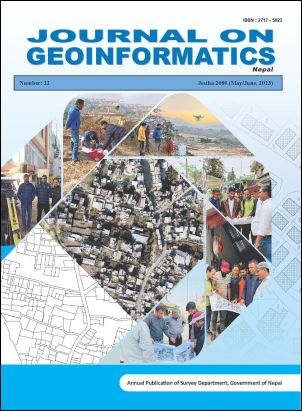Application of Geo-informatics for Soil Erosion Mapping
DOI:
https://doi.org/10.3126/njg.v22i1.55116Keywords:
Geo-informatics, Universal Soil Loss Equation (USLE) , Soil erosion, ModelingAbstract
Soil erosion is a most severe environmental problem in hilly area. The study is carried out on Upper Bagmati River basin, North of Kathmandu valley having an area of 61 Sq.km. (approx). Universal Soil Loss Equation (USLE) model, with Geographic Information System (GIS) has been used to quantify the soil loss. Erosion modelling requires huge amount of information and data, usually coming from different sources and available in different formats and scales and for management of these data, GIS was used, which helped considerably in organizing the spatial data representing the effects of each factor affecting soil erosion. Five essential parameters of USLE Rainfall erosivity factor (R), Soil erodibility Factor (K), Slope length and steepness (LS) factor, Cropping management factor (C) and Support practice factor (P) have been used to estimate soil loss amount in the study area. All of these layers have been prepared in Arc GIS using various data sources and data preparation methods. DEM was prepared from the contour data with the interval of 20m which was used to generate LS factor. The monthly rainfall data (2010) of 17 rain gauge stations within the catchment area have been used to predict the R factor. K, C and P factors in basin area are adopted from the literature. The spatial distribution map of soil loss of the basin has been generated and classified into six categories depending on the calculated soil erosion amount. The annual predicted soil loss ranges between 0 and 292.878 t/ha/y. Low soil loss (mean 9.7 t/ha/y) have been recorded under forested areas. The high rate (mean 40.4 t/ha/y) of soil erosion was found in the cultivation area.




